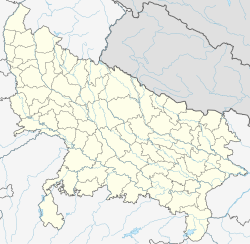Top Qs
Timeline
Chat
Perspective
Rumi Darwaza
Gateway in Lucknow, Uttar Pradesh, India From Wikipedia, the free encyclopedia
Remove ads
The Rumi Darwaza (sometimes known as the Turkish Gate), in Lucknow, Uttar Pradesh, India, is a gateway which was built by Nawab Asaf-Ud-Daula in 1784.[1] It is an example of Awadhi architecture.[1] The Rumi Darwaza is sixty feet tall[2] and was modeled after the Sublime Porte in Istanbul.[3]
It is adjacent to the Asafi Imambara, Teele Wali Masjid and used to mark the entrance to Old Lucknow. When the city grew and expanded, it was used as an entrance to a palace which was later demolished by the British Raj following the Indian Rebellion of 1857.[citation needed]
Remove ads
Etymology
The gate was modelled after a historical gate in Constantinople. Rumi refers to Rûm, the historical name used by the Islamic world to denote the region roughly corresponding to Anatolia, or the dominion of the former Eastern Roman Empire. "Rumi Darwaza" in Hindustani translates to "Turkish Gate" in English.[4]
Design
The darwaza is distinct from Mughal architecture in terms of style and materials used. The design consists of a big arch and on top of that, there is a half-spherical dome resting on half-octagonal plan. The gate is built using thin burnt clay bricks and lime-crushed brick aggregate mortar (Lakhori and Surkhi respectively, which was prevalent during the rule of Nawabs in the 18th century). The gate boasts of intricate carvings of flowers.[5][6][7]
Remove ads
Location
The gate is between Bara Imambara and Chota Imambara.
Gallery
- Rumi Darwaza or Roomi Gate in Lucknow
- Darwaza viewed from the front
- Rumi Gate (far background) and Bara Imambara
- Darwaza viewed from the back
- Darwaza viewed at night
- Rumi Darwaza viewed from Bara Imambara
- A long exposure photograph of the gate at night
See also
Wikimedia Commons has media related to Rumi Darwaza.
References
External links
Wikiwand - on
Seamless Wikipedia browsing. On steroids.
Remove ads















